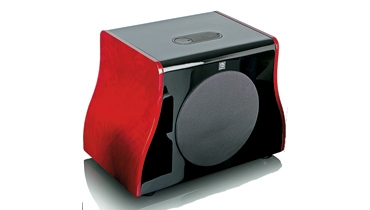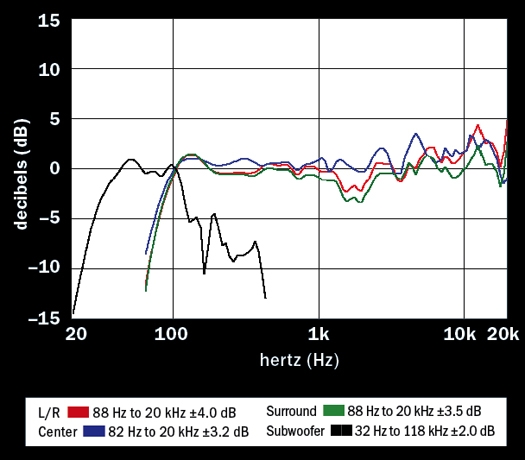Boston Acoustics VS Series home theater speaker system Page 3

TEST BENCH

Sensitivity (SPL at 1 meter with 2.8 volts of pink-noise input) front left/right/surround: 83 dB center: 86 dB
Impedance (minimum/nominal) front left/right/surround: 3.1/9 ohms center: 5.1/8 ohms
Bass limits (lowest frequency and maximum SPL with limit of 10% distortion at 2 meters in a large room) front left/right/surround: 80 Hz at 84 dB center: 80 Hz at 80 dB subwoofer: 25 Hz at 83 dB SPL 97 dB average SPL from25 to 62 Hz 103 dB maximum SPL at 62 Hz bandwidth uniformity 94%
All of the curves in the frequency-response graph are weighted to reflect how sound arrives at a listener's ears with normal speaker placement. The curve for the left/right front channels reflects response of the VS240 averaged over a ±30º window. The center-channel curve reflects response of the VS224 averaged over ±45º, with double weight directly on-axis of the primary listener. The surround-channel curve shows the response of the VS240 averaged over ±60º.
Both the VS240 and VS224 speakers were measured on a 6-foot stand, which gives anechoic results to approximately 200 Hz. All other measurements, subwoofer excepted, were taken at a full 2 meters. This arrangement emulates a typical listening distance, allows larger speakers to fully integrate acoustically, and, unlike near-field measurements, fully includes front panel reflections and cabinet diffraction.
The VS240 has a rising response in the top octave and becomes quite directional by ±30º off-axis. There is some irregularity above 3 kHz, along with a dip just below 2 kHz that becomes more evident at wider listening angles. The speaker also has unusually low sensitivity and impedance that dips down to a low 3.1 ohms. The VS224 has peaking above 2 kHz and a 1.5 kHz off-axis lobe that becomes increasingly severe at wider listening angles.
The VPS210 subwoofer's bass limits were measured with it set to maximum bandwidth (Crossover Bypass and Flat trim) and placed in the optimal corner of a 7,500-cubic-foot room. In a smaller room, users can expect 2 to 3 Hz deeper extension and up to 3 dB higher sound-pressure level (SPL ). As shown in the response graph, the subwoofer has relatively limited upper bandwidth even when its LFE input is used. When using the line inputs, the system only has an upper frequency bandwidth of 53 to 100 Hz, even though the crossover dial is marked from 40 to 150 Hz. There is also significant crossover/ level control interaction of up to -6 dB when settings in the lower end of the crossover frequency range are selected. Dynamic capability is limited, and protective circuitry can often be heard kicking in when the subwoofer is challenged by dynamic passages in music or movie soundtracks.
-Tom Nousaine












































